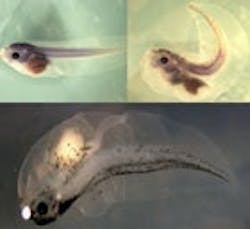Atrazine Found in U.S. Drinking Water and Watersheds
A widely used pesticide known to impact wildlife development and, potentially, human health has contaminated watersheds and drinking water throughout much of the U.S., according to a report released Aug. 24 by the Natural Resources Defense Council (NRDC).
Banned by the European Union, atrazine is the most commonly detected pesticide in U.S. waters and is a known endocrine disruptor, which means that it affects human and animal hormones. It has been tied to poor sperm quality in humans and hermaphroditic amphibians.
“Evidence shows Atrazine contamination to be a widespread and dangerous problem that has not been communicated to the people most at risk,” said Jennifer Sass, PhD, NRDC senior scientist and an author of the report. “[The U.S. Environmental Protection Agency] EPA is ignoring some very high concentrations of this pesticide in water that people are drinking and using every day. This exposure could have a considerable impact on reproductive health. Scientific research has tied this chemical to some ghastly impacts on wildlife and raises red flags for possible human impacts.”
“People living in contaminated areas need to be made aware—and the regulators need to get this product off the market,” Sass said.
The report, “Poisoning the Well: How the EPA is Ignoring Atrazine Contamination in Surface and Drinking Water in the Central United States,” creates a groundbreaking analysis of atrazine pollution by bringing together data from watershed monitoring and drinking water compliance programs for the first time.
The report reveals that all of the watersheds monitored by EPA and 90% of the drinking water sampled tested positive for atrazine. Contamination was most severe in Illinois, Iowa, Indiana, Missouri and Nebraska. An extensive U.S. Geological Survey study found that approximately 75% of stream water and about 40% of all groundwater samples from agricultural areas contained atrazine, and according to the New York Times, an estimated 33 million Americans have been exposed to atrazine through their drinking water systems.
"The extent of contamination we found in the data was breathtaking and alarming,” said Andrew Wetzler, director of NRDC’s Wildlife Conservation Program and deputy director of NRDC’s Midwest Program, as well as one of the report’s authors. “The EPA found atrazine almost everywhere they looked. I think that the public will find this hard to swallow and I hope it will help force the EPA to address the situation more aggressively.”
The contamination data in the report was obtained as the result of a legal settlement and Freedom of Information Act requests. “Poisoning the Well” highlights watersheds and municipal water treatment systems most affected by the chemical contamination, offers policy solutions and describes actions that people can take to protect themselves from exposure to this dangerous chemical in their water.
Atrazine is regulated by the EPA. Under the Safe Drinking Water Act (SDWA), EPA has determined that an annual average of no more than 3 parts per billion (ppb) of atrazine may be present in drinking water. One of the chief findings of the report was that this reliance on a “running annual average” allows levels of atrazine in drinking water to peak at extremely high concentrations.
Given the pesticide’s limited economic value and the fact that safer agricultural methods can be substituted to achieve similar results, NRDC recommends phasing out the use of atrazine, more effective atrazine monitoring and the adoption of farming techniques that can help minimize the use of atrazine to prevent it from running into waterways. The report also underscores the importance of using home filtration systems.
The effects associated with atrazine have been documented extensively. Reproductive effects have been seen in amphibians even at low levels of exposure. Concentrations as low as 0.1 ppb, for example, have been shown to alter the development of sex characteristics in male frogs, resulting in male frogs with female sex characteristics and the presence of eggs in male frog testes. Some scientists are concerned about exposure for children and pregnant women, as small doses could impact development of the brain and reproductive organs. Research has also raised concerns about atrazine’s “synergistic” affects, showing potential for the chemical having a multiplier affect to increase toxic affects of other chemical co-contaminants in the environment.
The report includes information on actions people can take to protect themselves from Atrazine and other dangerous contaminants. NRDC recommends that consumers concerned about atrazine contamination in their water use a simple and economical household water filter, such as one that fits on the tap. Consumers should make sure that the filter they choose is certified by NSF Intl. to meet American National Standards Institute (ANSI) Standard 53 for VOC (volatile organic compounds) reduction and therefore capable of significantly reducing many health-related contaminants, including atrazine and other pesticides.
The full NRDC report is available here.
Source: National Resources Defense Council
